Storage and Digestion Organelles
Objective 5.13
5.13.1 Name and classify the organelles involved in the storage and digestion of materials within the cell.
This detail from Don Fawcett’s diagram of the cell organelles focuses on the storage and digestion organelles, the last set we’ll examine. These are SER for storage, and lysosomes, peroxisomes, and proteasomes for digestion. SER for digestion is not shown and will not be discussed.
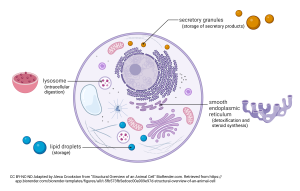
Storage SER
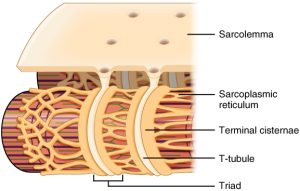 When we study muscles in Unit 10, we will see that along with the actin filaments that are a beautiful expression of the cytoskeleton, there are equally beautiful elements of the smooth endoplasmic reticulum (SER) which are used for an essential storage function.
When we study muscles in Unit 10, we will see that along with the actin filaments that are a beautiful expression of the cytoskeleton, there are equally beautiful elements of the smooth endoplasmic reticulum (SER) which are used for an essential storage function.
Because these were named before they were recognized as SER, they are called sarcoplasmic reticulum (sarco– is Latin for “flesh” or “muscle”). The sarcoplasmic reticulum stores calcium ions (Ca2+). That Ca2+ is then released when the muscle is preparing to contract, and it’s the Ca2+ that sets into motion a series of events that result in muscle contraction. Put the Ca2+ back in its bag, and muscles relax.
Lysosomes
We’ve seen that the Latin prefix lyso– means “breaking apart” (as in glycolysis or hydrolysis) and –soma means “body”, so it stands to reason that lysosomes are organelles that break things apart. The lysosome are the workhorse recycling bin: among the things that are broken down by lysosomes are misfolded or unwanted proteins; invaders who attempt to gain entry to the cell by endocytosis; or metabolic toxins that could do damage to the cell. Lysosomes have a pH of 5.0, which means they are over 100 times more acidic than the cytoplasm that surrounds them (pH 7.4). They achieve this state with proton (H+) pumps, which acidify the inside of the vesicle. Inside, there are enzymes which are “tuned” to work most efficiently at acid pH. This would all do harm to the cell if we didn’t surround the lysosome with a lipid bilayer to keep its contents from mixing with the cytosol.
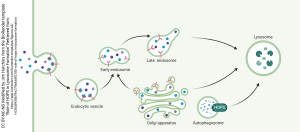
Peroxisomes
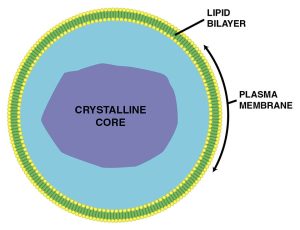
Peroxisomes are a bit more specialized than lysosomes. You probably guessed already that the inside of a peroxisome is filled with hydrogen peroxide (H2O2). The cell uses it for the same reason that you keep hydrogen peroxide in your medicine cabinet: it breaks down to free radical oxygen, and free radical oxygen is electronegative enough to be chemically reactive with most anything. In practice, the peroxisome is more of a lipid breakdown organelle.
Two enzymes are notably found in peroxisomes. The first is catalase, which catalyzes (!) the breakdown of 2H2O2 into 2H2O and O2. That’s why when you pour hydrogen peroxide on a wound, it foams up: catalase in your skin is breaking down the peroxide into water and oxygen gas.
In the center of the peroxisome, you may notice what scientists call a paracrystalline array but that’s just a fancy name for an organized grain of something. That something (which you do not need to know, but I’m spinning a tale here) are crystals of the enzyme urate oxidase. The peroxisome breaks down uric acid with this enzyme.
Proteasomes
The last organelle we’ll meet in Unit 5 is the proteasome. The good thing about the digestion organelles is that it’s easy to figure out what they do based on the names — proteasomes break down proteins.
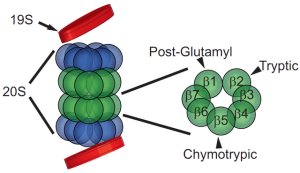
If you look at the structure of a proteasome, it vaguely resembles a paper shredder. You can think of it as a protein shredder. Ubiquitin is protein which is found everywhere — it’s ubiquitous. Ubiquitin is the “hand” that feeds proteins into the shredder, then disassembles and assembles around another protein. Instead of paper shreds, the proteasome generates amino acids and spits them out the bottom of the structure shown.
Media Attributions
- U05-056 storage_digestion organelles (1) © Crookston, Alexa is licensed under a CC BY-NC-ND (Attribution NonCommercial NoDerivatives) license
- U05-057 1023_T-tubule © Betts, J. Gordon; Young, Kelly A.; Wise, James A.; Johnson, Eddie; Poe, Brandon; Kruse, Dean H. Korol, Oksana; Johnson, Jody E.; Womble, Mark & DeSaix, Peter is licensed under a CC BY (Attribution) license
- U05-058 Lysosome Formation © Hutchins, Jim is licensed under a CC BY-NC-ND (Attribution NonCommercial NoDerivatives) license
- U05-059 Peroxisome © Agateller is licensed under a Public Domain license
- U05-062 Proteasome_Inhibition_-_Thinking_Outside_the_Box_(7126489699) © Libertas Academica is licensed under a CC BY (Attribution) license

